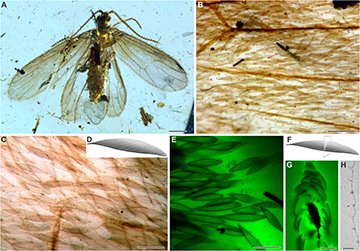
Tarachoptera from mid-Cretaceous Burmese amber. [Image: Qingqing Zhang et al.; Bo Wang, Nanjing Institute of Geology and Palaeontology, Chinese Academy of Sciences]
Many contemporary animals and plants get their vivid colors from tiny surface structures that scatter incident light, and they use the resulting visual effects to attract mates or hide from predators. Yet, how the nanostructure coloration originated in certain species, including the Lepidoptera family (butterflies and moths), has eluded scientists until recently.
Researchers in China and several European countries used four different types of microscopy to study the scales in the wings of ancient fossil lepidopterans, some preserved in prehistoric amber (Sci. Adv., doi:10.1126/sciadv.1700988). Subsequent optical modeling revealed the colors produced by these natural nanoscale photonic arrays—the earliest evidence of structure-based colors in insects.
Fossil wing structures
The international team, led by Bo Wang of the Nanjing Institute of Geology and Palaeontology, characterized the periodic structure of the scales on six fossil insects from China, the United Kingdom, Germany and Kazakhstan. For example, the oldest of the fossils, dating from the early Jurassic Period, had wings covered with scales 100 to 110 μm long, each with parallel ridges 1.8 to 2 μm apart. Under scanning electron microscopy and optical microscopy, these cover scales, which sat atop a second layer of ground scales, resembled those of an existing species of moth from the family Micropterigidae.
The periodicities of the wing structures in these six fossils ranged from 140 to 2000 nm—from the ultraviolet to short-wavelength infrared—so the researchers modeled the response of structures with similar shapes and periodicities to light. The finite-element-method simulations showed that the longitudinal parallel ridges on many of the fossil lepidopteran scales were enough to produce coherent optical scattering, and zeroth-order diffraction would have given the wings a broadband metallic sheen, similar to thin-film interference effects, which would have changed slightly under polarized light.
Preserved in amber
Under transmission electron microscopy and confocal laser scanning microscopy, the team also examined amber-preserved Cretaceous Period fossils from an insect family named Tarachoptera, related to Lepidoptera. These creatures had smaller scales, 30 to 50 μm in size, arranged in a single layer. The two families are thought to have diverged from a common ancestral line.
Scientists from universities and museums in Germany, Ireland, England and Scotland were also involved in the study.
